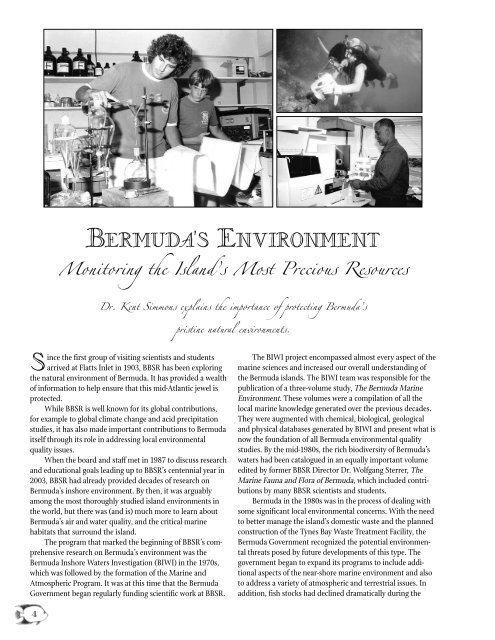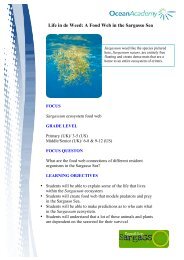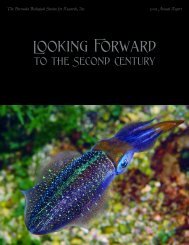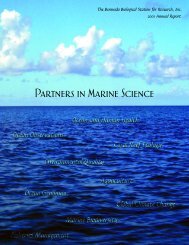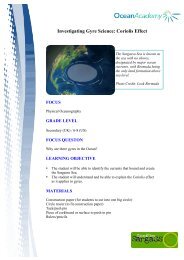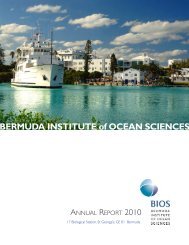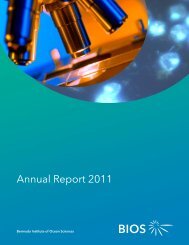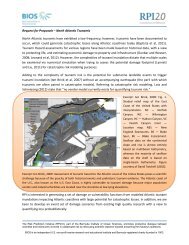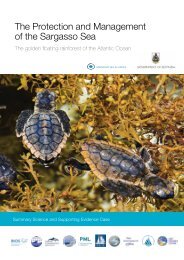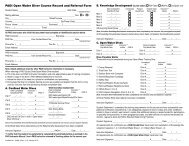Since the first group <strong>of</strong> visiting scientists and studentsarrived at Flatts Inlet in 1903, <strong>BBSR</strong> has been exploringthe natural environment <strong>of</strong> <strong>Bermuda</strong>. It has provided a wealth<strong>of</strong> information to help ensure that this mid-Atlantic jewel isprotected.While <strong>BBSR</strong> is well known for its global contributions,for example to global climate change and acid precipitationstudies, it has also made important contributions to <strong>Bermuda</strong>itself through its role in addressing local environmentalquality issues.When the board and staff met in 1987 to discuss researchand educational goals leading up to <strong>BBSR</strong>’s centennial year in2003, <strong>BBSR</strong> had already provided decades <strong>of</strong> research on<strong>Bermuda</strong>’s inshore environment. By then, it was arguablyamong the most thoroughly studied island environments inthe world, but there was (and is) much more to learn about<strong>Bermuda</strong>’s air and water quality, and the critical marinehabitats that surround the island.The program that marked the beginning <strong>of</strong> <strong>BBSR</strong>’s comprehensiveresearch on <strong>Bermuda</strong>’s environment was the<strong>Bermuda</strong> Inshore Waters Investigation (BIWI) in the 1970s,which was followed by the formation <strong>of</strong> the Marine andAtmospheric Program. It was at this time that the <strong>Bermuda</strong>Government began regularly funding scientific work at <strong>BBSR</strong>.4BERMUDA’S ENVIRONMENTMonitoring the Island’s Most Precious ResourcesDr. Kent Simmons explains the importance <strong>of</strong> protecting <strong>Bermuda</strong>’spristine natural environments.The BIWI project encompassed almost every aspect <strong>of</strong> themarine sciences and increased our overall understanding <strong>of</strong>the <strong>Bermuda</strong> islands. The BIWI team was responsible for thepublication <strong>of</strong> a three-volume study, The <strong>Bermuda</strong> MarineEnvironment. These volumes were a compilation <strong>of</strong> all thelocal marine knowledge generated over the previous decades.They were augmented with chemical, biological, geologicaland physical databases generated by BIWI and present what isnow the foundation <strong>of</strong> all <strong>Bermuda</strong> environmental qualitystudies. By the mid-1980s, the rich biodiversity <strong>of</strong> <strong>Bermuda</strong>’swaters had been catalogued in an equally important volumeedited by former <strong>BBSR</strong> Director Dr. Wolfgang Sterrer, TheMarine Fauna and Flora <strong>of</strong> <strong>Bermuda</strong>, which included contributionsby many <strong>BBSR</strong> scientists and students.<strong>Bermuda</strong> in the 1980s was in the process <strong>of</strong> dealing withsome significant local environmental concerns. With the needto better manage the island’s domestic waste and the plannedconstruction <strong>of</strong> the Tynes Bay Waste Treatment Facility, the<strong>Bermuda</strong> Government recognized the potential environmentalthreats posed by future developments <strong>of</strong> this type. Thegovernment began to expand its programs to include additionalaspects <strong>of</strong> the near-shore marine environment and alsoto address a variety <strong>of</strong> atmospheric and terrestrial issues. Inaddition, fish stocks had declined dramatically during the
previous two decades. Research conducted by scientists at<strong>BBSR</strong>, the Department <strong>of</strong> Agriculture and Fisheries, and the<strong>Bermuda</strong> Aquarium was influential in the government’sdecision to ban the use <strong>of</strong> commercial fish pots in 1990.To address these concerns, <strong>BBSR</strong>’s <strong>Bermuda</strong> researchprograms hired a number <strong>of</strong> new scientists, like BermudiansDr. Robbie Smith and myself. The 1987 workshop participantsreaffirmed the importance <strong>of</strong> this research. Both Dr.Smith and I came up through the ranks as students in <strong>BBSR</strong>’seducational programs, including the <strong>Bermuda</strong> Programme,which has now provided summer internships to Bermudianundergraduate students for more than two decades. In thisprogram, I worked under the supervision <strong>of</strong> <strong>BBSR</strong> scientistsTony Knap and Tim Jickells and was motivated to pursue acareer in marine science.After receiving my doctorate in 1987 from the University<strong>of</strong> New Hampshire for my dissertation research on <strong>Bermuda</strong>’sgroundwater, I returned to <strong>BBSR</strong> as afull-time scientist. I have beenworking for many years on atmosphericand terrestrial problems andstudying the impacts <strong>of</strong> the TynesBay Incinerator ash and smoke stackemissions. Incinerator ash is the byproduct<strong>of</strong> waste combustion, inwhich domestic waste is reduced bysome 90 percent <strong>of</strong> its initial volume.The ash is thought to contain heavymetals and organic contaminantsthat, if disposed <strong>of</strong> incorrectly, pose asignificant threat to the local environment.Likewise, the smoke stackemissions contain acidic gases such as sulfur dioxide andnitrogen oxides, particulates, metals and organics that potentiallyimpact ro<strong>of</strong>tops and drinking water, soils andvegetation. Environmental monitoring has been a criticalaspect <strong>of</strong> this program to help ensure that the ash is disposed<strong>of</strong> properly and that stack emissions are controlled.Also developing in conjunction with the waste treatmentfacility was Robbie Smith’s Benthic Ecology Research Program(BERP). After receiving his doctorate in 1991 from theUniversity <strong>of</strong> Georgia, Dr. Smith also returned to <strong>BBSR</strong>,focusing much <strong>of</strong> his attention on problems linked to thedisposal <strong>of</strong> incinerator ash in the near-shore waters. Manyorganisms bioaccumulate contaminants within their tissues;as these contaminants are magnified up through the foodchain, they can reach potentially toxic levels. The BERP teamcurrently monitors the health <strong>of</strong> <strong>Bermuda</strong>’s coral reefs,seagrass beds and mangroves, provides information relevantto the management <strong>of</strong> marine resources, and examinesThe quality <strong>of</strong> <strong>Bermuda</strong>’s air andwater and the diversity <strong>of</strong> thespecies found in its waters are thefoundation for the quality <strong>of</strong> lifeenjoyed by both residents andvisitors to the island.potential environmental impacts while contributing to ouroverall understanding <strong>of</strong> ecological processes. Dr. Smith’steam now includes scientists Dr. Shane Paterson and GrahamWebster, and two additional former <strong>Bermuda</strong> Programmeinterns, Dr. Joanna Pitt and Ph.D. candidate ThaddeusMurdoch. With support from the <strong>Bermuda</strong> Government, ThePew Charitable Trusts, the Curtis and Edith MunsonFoundation, and the U.S. National Fish and WildlifeFoundation, this team is conducting extensive research on theeffectiveness <strong>of</strong> <strong>Bermuda</strong>’s marine protected areas as a modelfor other nations to protect their coral reef fisheries.While many <strong>of</strong> the <strong>Bermuda</strong> environmental qualitystudies can be linked back to the development <strong>of</strong> the TynesBay Waste Treatment Facility, other programs have foundtheir origin elsewhere. <strong>BBSR</strong>’s Analysis <strong>of</strong> Marine Pollutionsummer course, <strong>of</strong>fered since the 1970s, identified in the mid-1990s the antifouling paint compounds tributyl tin (TBT) andIrgarol 1051 in several <strong>of</strong> <strong>Bermuda</strong>’senclosed harbors. TBT is knownworldwide for its toxic effects onmarine organisms, and effectiveJanuary 1, 2003, the InternationalMaritime Organization banned itsuse in many countries, including<strong>Bermuda</strong>.Dr. Richard Owen’s ecotoxicologygroup at <strong>BBSR</strong>, working withcolleagues from the UnitedKingdom, has demonstrated thatIrgarol 1051, the compoundexpected to replace TBT as theadditive <strong>of</strong> choice for antifoulingpaints, has a devastating impact on coral photosynthesis atlow levels, similar to levels already measured in the marineenvironment. An important publication in <strong>2002</strong> by Dr. Owen,with Dr. Tony Knap, Kelly Carberry and Lucy Buxton, documentedthis global threat to coral reef environments. Similar<strong>BBSR</strong> studies have focused on the determination <strong>of</strong> pesticidesin <strong>Bermuda</strong>’s groundwater, and scientists are working t<strong>of</strong>ormulate an early warning diagnostic assay <strong>of</strong> pollutantexposure and impact for marine organisms.The quality <strong>of</strong> <strong>Bermuda</strong>’s air and water and the diversity<strong>of</strong> the species found in its waters are the foundation for thequality <strong>of</strong> life enjoyed by both residents and visitors to theisland. Since the 1987 long-range planning workshop,research and education programs at <strong>BBSR</strong> have contributedgreatly to local understanding <strong>of</strong> the environment, and, Ibelieve, have helped ensure its protection. My colleagues and Ilook forward to continuing to monitor these importantresources in <strong>BBSR</strong>’s second century.Left: Dr. Thomas Sleeter investigates oil pollution as a graduate student at <strong>BBSR</strong> in the 1970s. A young student looks on.Upper right: A <strong>BBSR</strong> summer course student monitors the health <strong>of</strong> a coral reef in <strong>Bermuda</strong>’s inshore watersLower right: Associate Research Scientist Dr. Kent Simmons uses an Atomic Absorption Spectrophotometer to analyze <strong>Bermuda</strong> air andsoil samples for traces <strong>of</strong> heavy metals5


